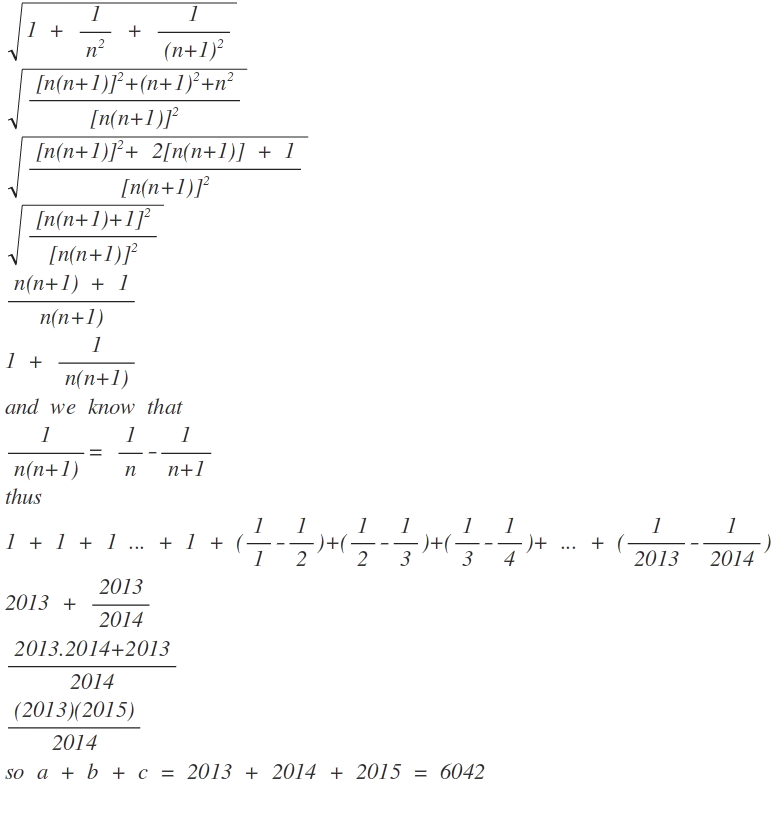Let The Telescoping Dance
1 + 1 2 1 + 2 2 1 + 1 + 2 2 1 + 3 2 1 + 1 + 3 2 1 + 4 2 1 + . . . + 1 + 2 0 1 3 2 1 + 2 0 1 4 2 1 = b a c
If three consecutive natural numbers a , b and c satisfy the equation above, what is a + b + c ?
The answer is 6042.
This section requires Javascript.
You are seeing this because something didn't load right. We suggest you, (a) try
refreshing the page, (b) enabling javascript if it is disabled on your browser and,
finally, (c)
loading the
non-javascript version of this page
. We're sorry about the hassle.
3 solutions
Hi! Great solution. Can you tell me how to find the the general term? Is it by observation..or any fornula?
Log in to reply
In this case it is by observation, but it can also be proved.
The summation is given as follows, where n = 2 0 1 3 :
S = k = 1 ∑ n 1 + k 2 1 + ( k + 1 ) 2 1 = k = 1 ∑ n k 2 ( k + 1 ) 2 k 2 ( k + 1 ) 2 + ( k + 1 ) 2 + k 2 = k = 1 ∑ n k 2 ( k + 1 ) 2 k 4 + 2 k 3 + 3 k 2 + 2 k + 1 = k = 1 ∑ n k 2 ( k + 1 ) 2 ( k 2 + k + 1 ) 2 = k = 1 ∑ n k ( k + 1 ) k 2 + k + 1 = k = 1 ∑ n ( 1 + k ( k + 1 ) 1 ) = k = 1 ∑ n ( 1 + k 1 − k + 1 1 ) = n + 1 1 − n + 1 1 = n + 1 ( n + 1 ) 2 − 1 = n + 1 n ( n + 2 )
⟹ a + b + c = n + n + 1 + n + 2 = 3 ( n + 1 ) = 3 ( 2 0 1 4 ) = 6 0 4 2
Mas Mus , nice problem. But you don't need to enter text in LaTex. It is difficult and it is not a standard practice in Brilliant/org. It doesn't necessary look good.
sir how did u do n+1/1*1/n+1
Log in to reply
There is no n + 1 1 × n + 1 1 but n + 1 1 − n + 1 1 .
Log in to reply
sir i am sorry but i typed my question wrong
Log in to reply
@Erica Phillips – n + 1 1 − n + 1 1 = n + 1 − n + 1 1 = n + 1 ( n + 1 ) 2 − 1
Did the same way
thank u for explaining it well

Observing the series --
1 + 1 1 + 4 1 = 2 3
1 + 4 1 + 9 1 = 6 7
1 + 9 1 + 1 6 1 = 1 2 1 3
1 + 1 6 1 + 2 5 1 = 2 0 2 1
So the general term can be put as -
t n = ( n + 1 ) 2 − ( n + 1 ) ( n + 1 ) 2 − n = n 2 + n n 2 + n + 1
= 1 + n ( n + 1 ) 1 = 1 + n 1 − n + 1 1
Sum till n = 2 0 1 3
= 1 ∗ 2 0 1 3 + 1 1 − 2 0 1 4 1 = 2 0 1 4 ( 2 0 1 3 ) ∗ ( 2 0 1 5 ) = b a c